“Starships are meant to fly. It sure as hell flew today. So let’s get ready for the next one.”
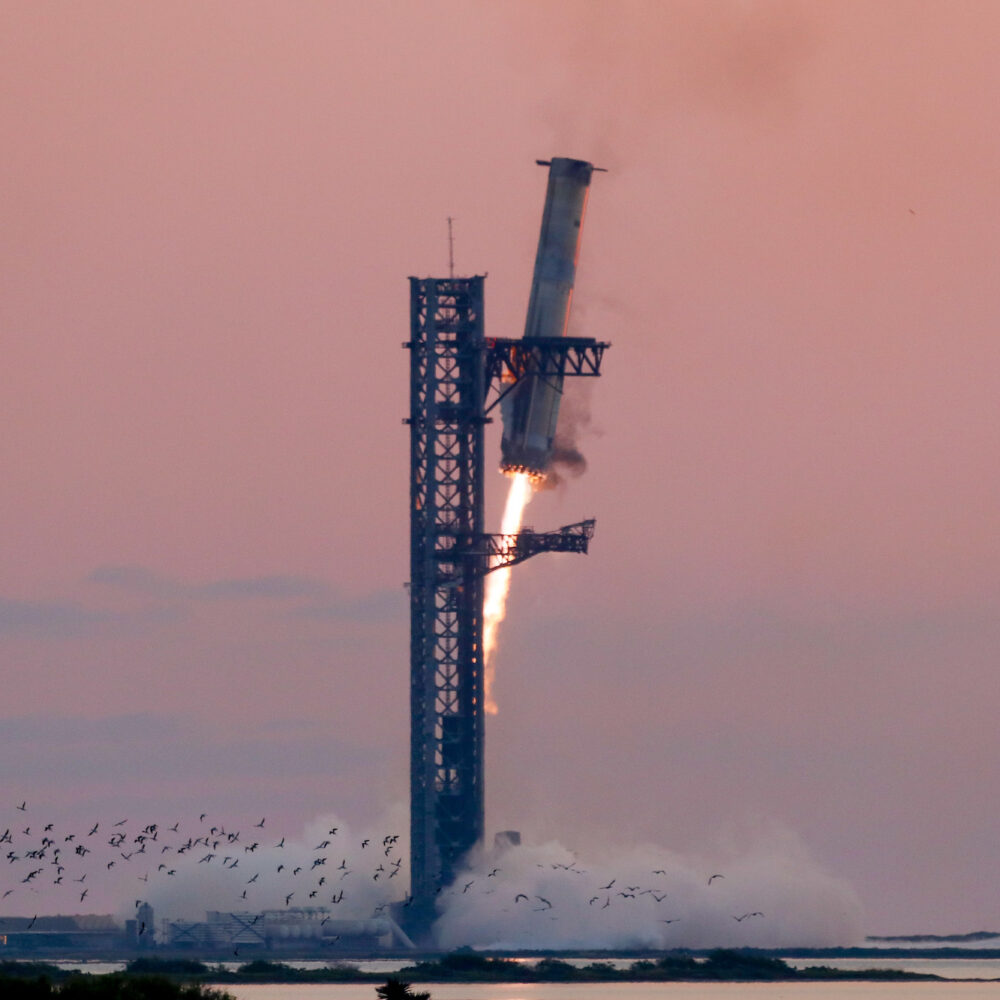
The Super Heavy booster, more than 20 stories tall, rights itself over the launch pad in Texas, moments before two mechanical arms grabbed it in mid-air. Credit: Stephen Clark/Ars Technica
BOCA CHICA BEACH, Texas—SpaceX accomplished a groundbreaking engineering feat Sunday when it launched the fifth test flight of its gigantic Starship rocket and then caught the booster back at the launch pad in Texas with mechanical arms seven minutes later.
This achievement is the first of its kind, and it’s crucial for SpaceX’s vision of rapidly reusing the Starship rocket, enabling human expeditions to the Moon and Mars, routine access to space for mind-bogglingly massive payloads, and novel capabilities that no other company—or country—seems close to attaining.
The test flight began with a thundering liftoff of the 398-foot-tall (121.3-meter) Starship rocket at 7:25 am CDT (12:25 UTC) from SpaceX’s Starbase launch site in South Texas, a few miles north of the US-Mexico border. The rocket’s Super Heavy booster stage fired 33 Raptor engines, generating nearly 17 million pounds of thrust and gulping 20 tons of methane and liquid oxygen propellants per second at full throttle.
This is twice the power of NASA’s Saturn V rocket, which was used to send astronauts to the Moon more than 50 years ago.
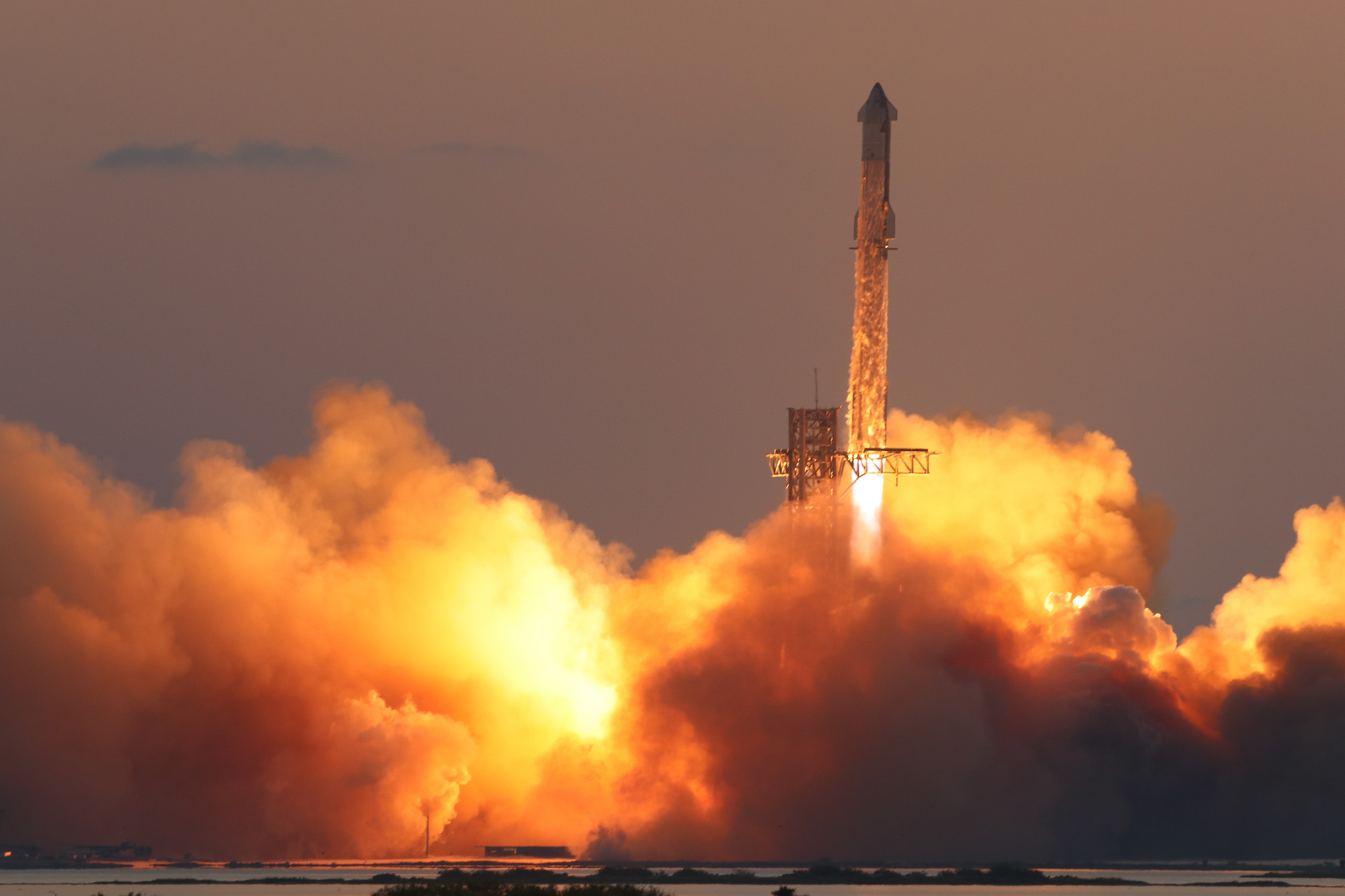
After a vertical ascent from its coastal launch pad, the Starship rocket arced toward the east over the Gulf of Mexico. All 33 engines fired for more than two-and-a-half minutes, accelerating the rocket to nearly 3,300 mph (5,300 km/hr) before shutting off as the Starship upper stage ignited six more Raptor engines to continue the climb into space.
While Starship executed a seemingly flawless engine firing to accelerate itself to near orbital velocity, most observers, whether watching SpaceX’s live webcast or attending the launch in person, kept their eyes glued on the Super Heavy booster.
Ars Video
How The Callisto Protocol’s Team Designed Its Terrifying, Immersive Audio
High over the Gulf of Mexico, the rocket used its engines to reverse course and head back toward the Texas coastline. After reaching a peak altitude of 59 miles (96 kilometers), the Super Heavy booster began a supersonic descent before reigniting 13 engines for a final braking burn. The rocket then shifted down to just three engines for the fine maneuvering required to position the rocket in a hover over the launch pad. Crackling sonic booms rippled across the mud flats.
That’s when the launch pad’s tower, dubbed Mechazilla, ensnared the rocket in its two weight-bearing mechanical arms, colloquially known as “chopsticks.” The engines switched off, leaving the booster suspended perhaps 200 feet above the ground.
“That’s the first ever booster catch, a major step on the way to rapid reusability,” said Dan Huot, a SpaceX communications manager providing commentary on the company’s webcast of the test flight
During SpaceX’s previous four Starship test flights, the company sent the Super Heavy booster toward a controlled splashdown in the Gulf of Mexico, just off the coast of Texas. The boosters on the first three flights didn’t make it to the water intact, but on the fourth mission in June, the Super Heavy vehicle completed its descent to the sea with remarkable precision, within a half-centimeter of where it was supposed to go, according to Bill Gerstenmaier, SpaceX’s vice president of build and flight reliability.
That result gave SpaceX the confidence to try returning the booster to the launch pad on the fifth Starship mission. The Federal Aviation Administration, charged with ensuring public safety during commercial space launches, took an extra month to review SpaceX’s flight plan.
Finally, on Saturday, the federal regulator issued a license for SpaceX to launch Starship and attempt a recovery back at the launch pad. SpaceX was ready to go and gave the green light for final countdown preparations overnight, leading into Sunday morning’s launch window.
Starship hit a bullseye, too
As the dust settled at the launch pad, revealing the Super Heavy booster firmly in the grasp of the mechanical arms, cheers erupted at SpaceX’s rocket factory in Hawthorne, California, where the company hosted its live webcast of Sunday’s Starship test flight. After a collective release of tension, attention turned to Starship itself—essentially the rocket’s upper stage—as it shut down its six engines and began a 40-minute cruise halfway around the world.
At the end of the coast phase, Earth’s gravity pulled the ship back into the atmosphere. Live video downlinked from the rocket through SpaceX’s Starlink satellite Internet network showed a sheath of plasma enveloping the vehicle. Temperatures outside the ship were predicted to reach 2,600° Fahrenheit (1,430° Celsius), hot enough to melt aluminum. Starship and Super Heavy are made of more heat-resistant stainless steel.
Flying with its nose pitched up, Starship exposed its thousands of ceramic heat shield tiles to the blistering airflow during reentry. For this flight, SpaceX installed upgraded thermal protection tiles and added a secondary heat shield layer below them. During the previous Starship test flight in June, the scorching conditions of reentry stripped away parts of the heat shield and damaged the ship’s flaps, which it uses to help maintain control as it dives deeper into the atmosphere.
Still, the ship survived reentry and performed its landing burn, using three engines to slow for a relatively low-speed splashdown in the Indian Ocean. This accomplishment in June was the first time Starship itself, which SpaceX also designed to be reusable, reached the ground intact.
On Sunday’s test flight, Starship kept steady throughout the descent. There were some signs in video from onboard cameras showing relatively minor heating damage to some of the ship’s flaps, but nothing as significant as what SpaceX observed on the previous flight.
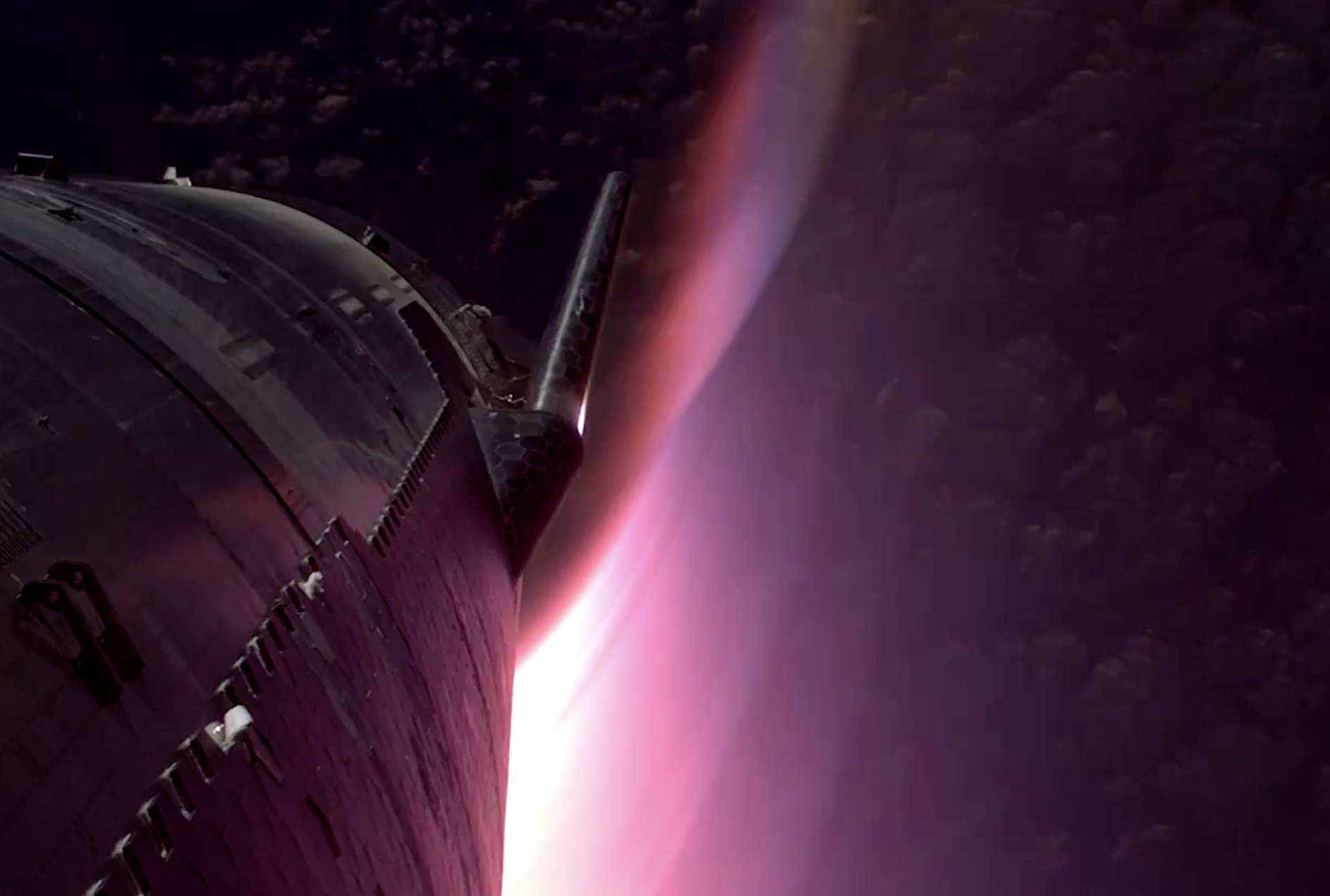
It was nighttime at Starship’s splashdown zone in the Indian Ocean. After slowing below the speed of sound, the ship flipped itself from a horizontal to a vertical orientation and lit its Raptor engines for a final braking maneuver, allowing the ship to settle into the sea within view of a camera on a nearby buoy. This confirmed Starship splashed down exactly where it was supposed to.
Video from the buoy showed the vehicle disintegrating in a fireball a few seconds after splashdown, an unsurprising outcome once the engines shut off and the ship toppled into the water.
“That was amazing,” said Kate Tice, a SpaceX engineer hosting the company’s live webcast of Sunday’s test flight. “We were not intending to recover any of the ship’s hardware, so that was the best ending that we could have hoped for.”
“Ship just gave us one heck of a show, making it through a controlled reentry this time, flaps intact, made it down to the water,” Huot said. “Starships are meant to fly. It sure as hell flew today. So let’s get ready for the next one.”
It started with a tweet
Elon Musk, SpaceX’s founder and CEO, first suggested his company’s plan to recover Starship’s first stage, called the Super Heavy booster, nearly four years ago.
“We’re going to try to catch the Super Heavy booster with the launch tower arm, using the grid fins to take the load,” Musk posted on Twitter in December 2020, two years before he purchased the social media platform and changed its name to X.
This approach is different from the way SpaceX lands the smaller Falcon 9 booster, its workhorse rocket. Falcon 9s have landing legs and typically land on floating drone ships hundreds of miles downrange in the ocean or at an onshore landing zone separate from its launch pad. SpaceX has landed Falcon 9 boosters more than 350 times, but the Super Heavy booster is 50 percent taller than the Falcon 9’s first stage and nearly two-and-a-half times its diameter.
This puts Super Heavy in a different league. Starship’s first stage booster is larger than the fuselage of a 747 jumbo jet. SpaceX’s mid-air catch of the Super Heavy booster Sunday looked a lot like Musk’s original description.
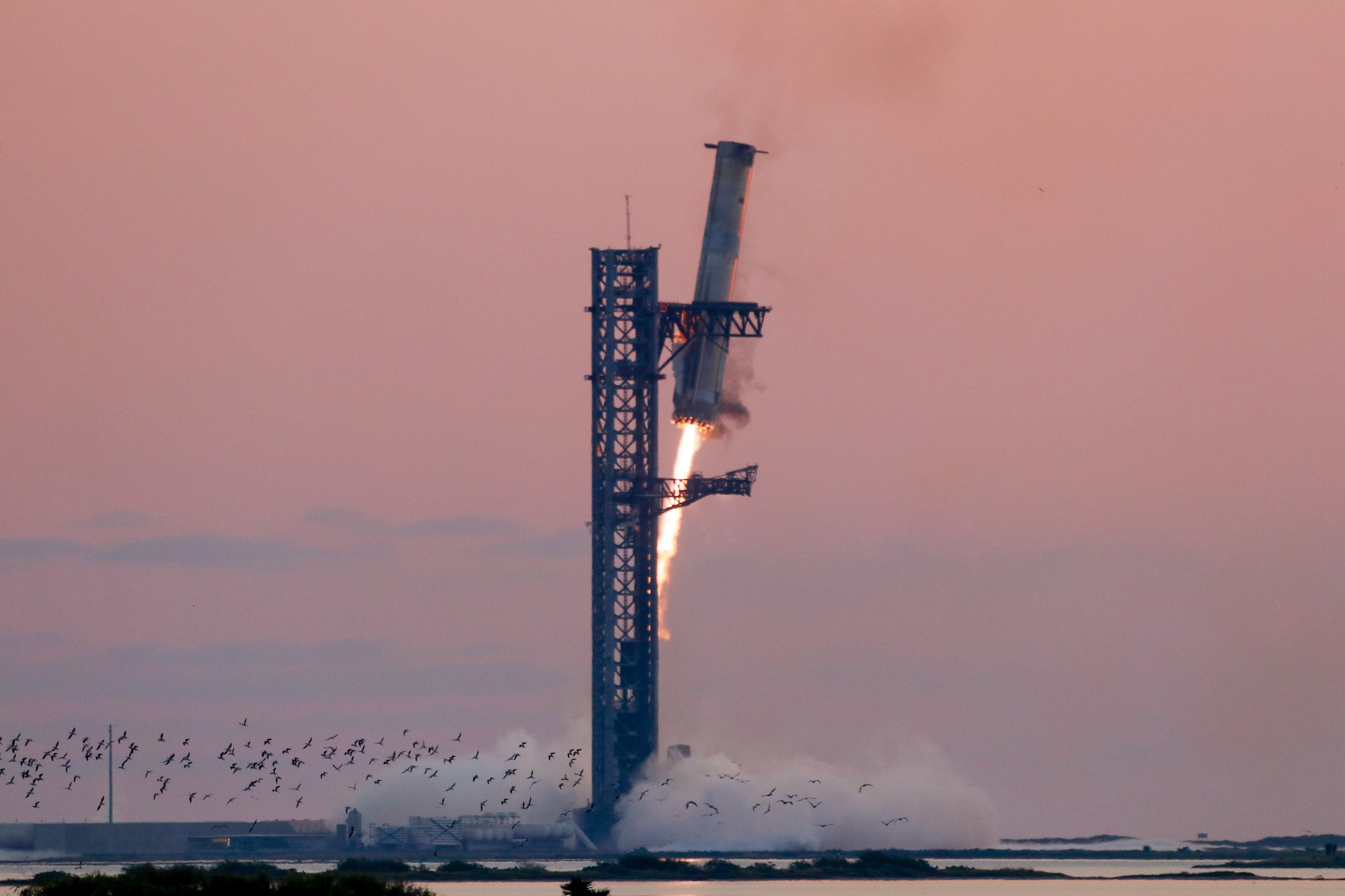
Eventually, SpaceX engineers want to master Starship launches and landings, then rapidly turn the rockets around for another flight. It takes at least several weeks for SpaceX to refurbish a Falcon 9 booster for another flight. With Starship, SpaceX wants to bring this turnaround time down to days or hours.
In his 2020 postings outlining the plan to catch Super Heavy boosters, Musk said the approach saves mass and eliminates the cost of landing legs. He wrote the plan also “enables immediate repositioning of the booster on to (the) launch mount,” making it “ready to refly in under an hour.”
In a speech at Starbase in April, Musk said he expected SpaceX to begin landing Starships back in Texas sometime in 2025. Like the booster, the ship will be caught using arms on the launch tower.
“Obviously, there’s a lot of work before we get there, but we just caught a booster,” Huot said toward the end of SpaceX’s webcast Sunday. “We’re going to start looking real soon at when we can catch a ship.”
What’s next?
SpaceX has not publicly disclosed its plans for the next flight of Starship or when it might happen. The FAA says it has already approved a launch license for SpaceX to fly the next Starship with the same mission profile as Sunday’s test flight. But SpaceX follows an iterative development process, meaning it will take lessons learned from Sunday and apply them to the next flight. Some elements of the next mission will likely change.
There are other things besides catching the ship on SpaceX’s to-do list at Starbase. One thing SpaceX will likely focus on soon is demonstrating that Starship can reignite its Raptor engines in space, something the ship needs to do to remove itself from low-Earth orbit and steer toward a guided reentry.
For these initial test flights, SpaceX intentionally put Starship on a suborbital trajectory that naturally brings it back into the atmosphere, ensuring the ship does not become stranded in space as an outsized piece of orbital debris. Unlocking orbital flight will allow SpaceX to start launching Starlink internet satellites on Starship and begin experimenting with in-space refueling, something that engineers must perfect for Starship to do what SpaceX wants it to do: enable human exploration of the Moon and Mars.
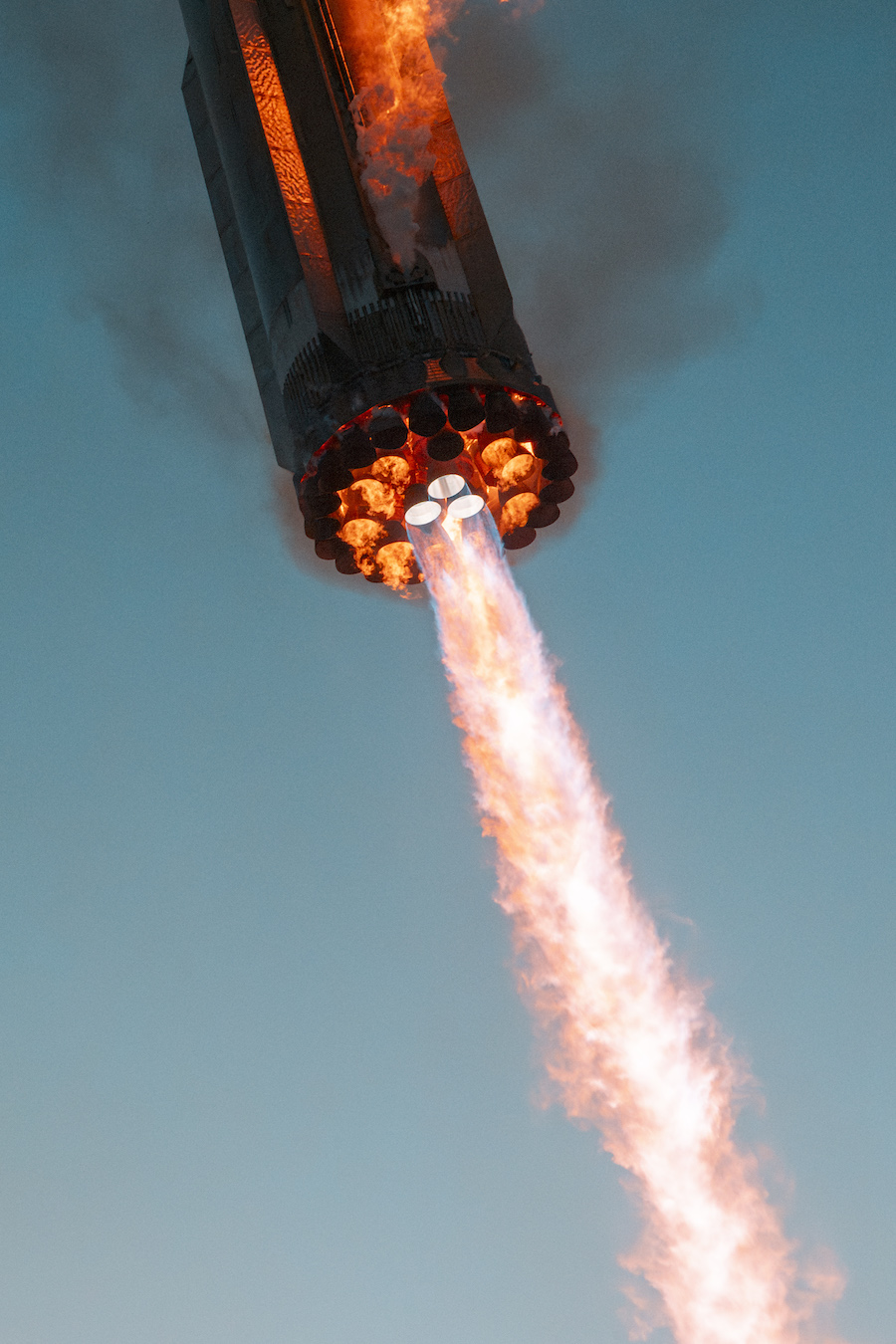
In recent months, SpaceX constructed a new launch tower just west of the existing Starship launch pad in South Texas. Crews are still working on the second launch pad, but it could come online next year. SpaceX also wants to activate two Starship launch pads at Cape Canaveral, Florida.
SpaceX has multiple boosters and ships in various stages of assembly in South Texas. The company says a sprawling new manufacturing facility called Starfactory will churn out multiple ships and boosters per week.
Engineers are developing two larger versions of Starship and Super Heavy to achieve the rocket’s performance goal of delivering more than 100 metric tons of payload mass to orbit. The long-term plan calls for several Starship variants, including ships outfitted for human passengers, refueling tankers, propellant depots, satellite deployers, and perhaps even a Starship-derived space station.
So far, NASA is SpaceX’s biggest customer for Starship. The agency is paying SpaceX $4 billion to develop two modified Starships as human-rated lunar landers for the Artemis program. Starship will transport astronauts from a position near the Moon to the lunar surface, then back into space for return to Earth on NASA’s Orion spacecraft.
SpaceX needs to launch a lot of Starships to make all this work. It could take 10 or more Starship refueling tankers to transfer enough super-cold methane and liquid oxygen into a propellant depot in low-Earth orbit. This depot would then refill the tanks of the Starship lunar lander with hundreds of tons of propellant once it launches on a Super Heavy booster, giving the lander enough endurance to travel to the Moon and take off again with NASA’s astronauts.
The upside of SpaceX’s architecture is that, with refueling, Starship can theoretically ferry payloads of 100 metric tons or more to the Moon or Mars, significantly more capacity than any other rocket. The ships could be refueled repeatedly and routinely transit between Earth and destinations in space, making all sorts of fascinating missions possible.
Sometime next year, SpaceX plans to launch a pair of Starships into orbit using its two side-by-side launch pads in Texas. The ships will dock together in orbit and test technologies to transfer cryogenic propellants, which has never been done in space at this scale. This demonstration is a precursor to future Artemis mission campaigns, when Starships must launch in rapid succession from multiple pads.
“There’s no doubt that the Human Landing System is the critical path for for Artemis III,” said Lori Glaze, acting deputy associate administrator for NASA’s exploration systems development division, referring to the Artemis program’s first lunar landing mission.
Artemis III is officially scheduled for launch in September 2026, but it’s likely to be delayed at least a couple of years due to the readiness of Starship and new commercially developed spacesuits to protect astronauts walking on the Moon’s surface. Ars has previously reported that NASA and SpaceX are assessing alternative mission profiles for Artemis III in case the Starship lunar lander faces longer delays.
“The pacing item is the rate at which SpaceX can launch the systems that can fuel the depot so that it’s prepared to fuel Starship for a lunar landing,” Glaze said last week. “So the real key there is them being able to get to a rate where they can launch at a rapid enough cadence.”
Multiple launch pads in Texas and Florida will allow SpaceX to ramp up its Starship launch cadence. Regular catches of the booster and ship will also be important for SpaceX to launch more often. That’s why, although NASA’s wasn’t directly involved in Sunday’s flight, agency officials were watching closely.
NASA Administrator Bill Nelson lauded Sunday’s successful test flight.
“Congratulations to SpaceX on its successful booster catch and fifth Starship flight test today!” Nelson posted on X. “As we prepare to go back to the Moon under Artemis, continued testing will prepare us for the bold missions that lie ahead—including to the South Pole region of the Moon and then on to Mars.”
“Thank you, sir! Looking forward to serving NASA in returning humanity to the Moon,” Musk replied.




